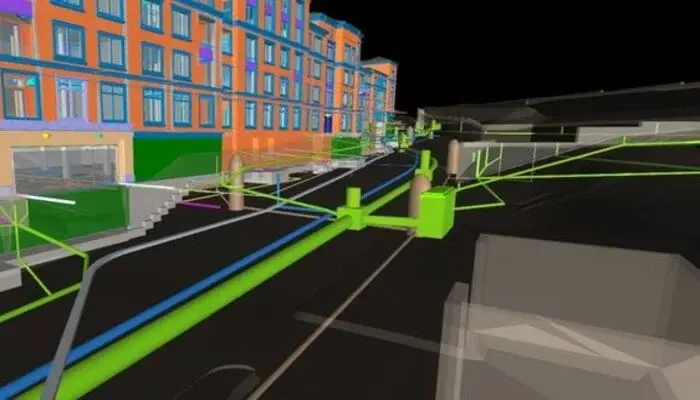-1.png)
In architecture, engineering, and construction (AEC), managing risk is a crucial part of ensuring any project’s success. Risk management in civil engineering consists of various factors like identifying, analysing, evaluating, and mitigating the potential risks that could impact the project's overall safety. Civil engineering projects are highly complex, involving numerous stakeholders, unique designs, and substantial financial investigation. It is one of the reasons why the importance of risk management in civil engineering cannot be overstated, as it plays a pivotal role in preventing unforeseen issues.
Building Information Modeling (BIM) has emerged as one of the best tools for the architecture and construction industry, offering multiple benefits for risk management in civil engineering projects. BIM is a digital representation of the physical and functional characteristics of a project, providing a platform for planning, designing, and managing construction projects.
Read further to learn about civil engineering risk management.
Understanding Risk Management in Civil Engineering
Civil engineering risk management is essential for successfully delivering construction projects. It involves a systematic and detailed procedure of identifying, solving, and mitigating the risks that later impact the project outcomes. The importance of risk management in civil engineering projects lies in its ability to eradicate delays, hazardous incidents, and budget overruns.
Besides this, the types of risk management in civil engineering can range from technical and financial risks to environmental and safety risks. Risk management examples in construction include using emergency funds, safety training programs, and an advanced tools list for comprehensive project oversight. For this, the risk management tools in construction include multiple software for risk assessment and BIM is one of them.
What is the Role of BIM in Risk Management?
BIM is one of the best tools for improving risk management for design and construction projects. It helps provide a detailed digital representation of the structure with functional characteristics. Various types of BIM tools enable better planning, drawing, and project execution for effective risk management. One of the primary BIM benefits is the ability to visualise the project in three dimensions.
Also Check out: BIM Adoption in the Civil Engineering - Overview, Benefits & Factors Affecting
BIM allows engineers and architects to detect potential design conflicts early in the planning stage, thereby reducing the chances for errors and rework during construction. This driven approach is a significant advantage in risk management for design and construction. The other BIM benefits are to offer effective communication and collaboration among architects and other stakeholders. Integrating various BIM tools further amplifies the effectiveness and efficiency of risk management.
Benefits of Using BIM Modelling for Risk Management
BIM is one of the greatest advancements in the AEC field, offering advanced risk management techniques. Integrating BIM tools is not only cost-effective but also offers complete collaboration and interaction between the teams. Below are the key BIM benefits for risk management for design and construction:
1. Enhanced Collaboration and Communication
BIM serves as a centralised platform where all project information is stored and accessed by the stakeholders. This shared environment helps in enhanced collaboration and communication among all stakeholders, including architects, engineers, contractors, and clients. By having access to up-to-date information, everyone involved can make informed decisions, reducing the changes of potential errors.
2. Better Visualisation and Planning
One of the most significant BIM benefits is its ability to provide a structure’s three-dimensional visual representation, allowing stakeholders to understand the project’s scope and identify potential issues early in the planning stage. BIM model helps in recognising design conflicts, spatial discrepancies, and other critical aspects that could lead to risks if not solved timely. This proactive approach is a cornerstone of the principles of risk management in construction.
3. Time Management
Delays are one of the biggest risks for construction projects, leading to increased costs and extended timelines. BIM tools for scheduling offer precise project timelines, identifying potential delays before they occur. These tools integrate all aspects of the construction process, providing the best view that helps in planning and executing tasks efficiently. By adhering to the principles of risk management in construction, effective time management through BIM modelling ensures that projects are completed on scheduled time.
4. Enhanced Resource Management
Effective resource management is another critical aspect of risk management in construction. BIM tools provide detailed insights into material quantities, equipment needs, and labour requirements. This information helps in optimising resource allocation, reducing wastage, and ensuring that the right resources are available at the right time. It aligns with various types of risk management in civil engineering, focusing on minimising risks related to resource allocation and management.
5. Accurate Cost Estimation and Budget Management
Managing financial risks is crucial in construction projects. BIM tools for cost estimation provide accurate and detailed budget forecasts, helping project managers allocate resources efficiently. These tools allow for real-time tracking of expenses and adjustments, ensuring that projects do not cross the budget line. By integrating cost management into the BIM process, financial risks can be minimised, leading to more predictable and controlled project outcomes.
BIM Implementation Strategies in Risk Management
A detailed planning and executing is vital in managing risks in civil engineering and construction projects. Effective BIM implementation can enhance the risk management process in the construction industry, providing multiple advantages. Here are some strategies for implementing BIM in risk management:
1. Comprehensive Risk Assessment and Planning
The first step in effective risk management in construction industry projects is doing a comprehensive risk assessment. BIM tools can facilitate this process by providing detailed project visualisations that help identify potential risks at various stages. By integrating risk assessment into the early planning phases, project managers can develop mitigation strategies based on the specific risks. This process aligns with the principles of risk management in construction, ensuring that potential issues are addressed before they reach the next stage.
2. Improved Safety Management
Safety is a critical aspect of risk management in construction industry projects. BIM can improve safety management by identifying potential hazards in the early project lifecycle. Detailed 3D models help visualise site conditions and plan safety measures accordingly. Additionally, BIM can facilitate safety training by creating virtual environments where workers can practise and understand safety protocols. This focus on safety aligns with the broader benefits of risk management in civil engineering, reducing accidents and enhancing project delivery.
3. Cost Management and Financial Risk Mitigation
Cost management is essential for successful risk and value management in construction. Integrating BIM tools can integrate cost estimation and budgeting into the risk management framework, providing accurate financial forecasts and identifying potential cost overruns. Monitoring expenses and comparing them closely with the planned budget, it helps mitigate financial risks. This ensures that projects remain financially viable and are completed within budget.
4. Effective Communication and Collaboration
Effective communication is crucial for successful risk and value management in construction. BIM tools provide a shared platform where all stakeholders can access up-to-date project information. This transparency encourages collaboration, ensuring that all parties are aware of potential risks and the steps being taken to mitigate them. Regularly updated BIM models help keep everyone on the same page, reducing the chances of miscommunication and enhancing overall project coordination.
5. Real-Time Monitoring
One of the key benefits of risk management in civil engineering using BIM is the ability to conduct real-time monitoring and reporting. BIM tools can continuously track project progress, identifying deviations from the plan that may indicate emerging risks. Real-time data allows for immediate response and adjustments, minimising potential impacts on the project. It helps in risk management and helps maintain project schedules and budgets, ensuring successful outcomes.
Also Check out: Top 10 Architecture Design Software
Future Trends and Opportunities
Civil engineering risk management is evolving rapidly, driven by advancements in technology, changes in frameworks, and increasing awareness of environmental sustainability. Let’s have a look at some future trends and opportunities in civil engineering risk management:
1. Increased Use of BIM
BIM continues to be a game-changer in the construction industry. BIM integration with risk management practices offers numerous benefits, such as improved visualisation, better communication, and real-time reporting. As BIM evolves in the near future, it will provide even more advanced solutions for identifying and mitigating risks throughout the project lifecycle.
2. Integration of Artificial Intelligence (AI)
AI is revolutionising risk management in civil engineering as it can analyse multiple data to identify patterns and predict potential risks. Its capability and features can provide real-time risk assessments, optimise resource allocation, and enhance decision-making processes.
3. Emphasis on Sustainability and Environmental Risks
As the importance of sustainability grows, so does the need to manage environmental risks in construction projects. Future trends in civil engineering risk management will increasingly focus on mitigating the impact of projects on the environment. Sustainable construction practices, such as green building materials and energy-efficient designs, will play a crucial role in minimising environmental risks and enhancing project value.
4. Development of Smart Infrastructure
Smart infrastructure incorporates advanced technologies, such as IoT sensors, AI, and data analytics to monitor and manage infrastructure in real-time. The development of smart infrastructure incorporates advanced technologies, such as IoT sensors, AI, and data analytics to monitor and manage infrastructure in real-time.
5. Adoption of Blockchain Technology
Blockchain technology has the potential to transform risk management in civil engineering by providing a secure and transparent way to manage project information. Blockchain can enhance data integrity, reduce fraud, and improve contract management. By creating an immutable record of transactions and project milestones, blockchain ensures accountability and trust among stakeholders. This technology can be particularly beneficial in managing financial risks and ensuring compliance with regulatory requirements.
The future of civil engineering risk management is marked by exciting trends and opportunities that promise to enhance the effectiveness of risk management practices.
Also Check out: BIM and Clash Detection: Ensuring Design Integrity
Conclusion
As technology continues to advance, the role of BIM in civil engineering risk management will only grow, providing even more sophisticated solutions to manage risks and add value to construction projects. Staying updated with the latest advancements and best practices in BIM is crucial for professionals looking to excel in this field. To deepen your understanding of BIM and its applications in risk management, you can consider enrolling in the BIM Professional Course for Civil Engineers offered by Novatr. You can learn 10+ BIM software and apply your learnings on capstone projects.
For more information and to stay updated with the latest trends, visit our Resource Page.
Was this content helpful to you









.jpg)
